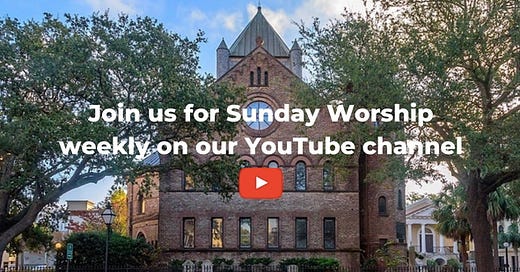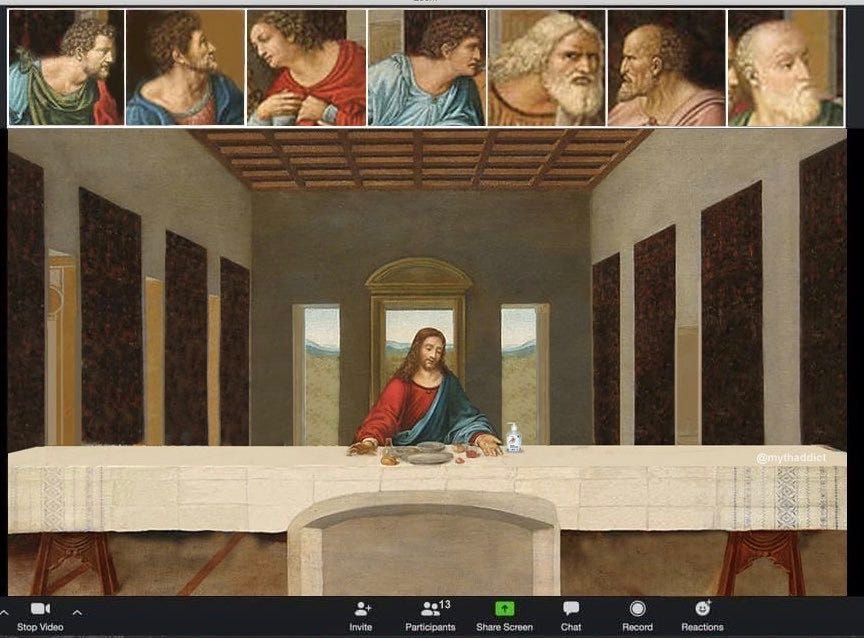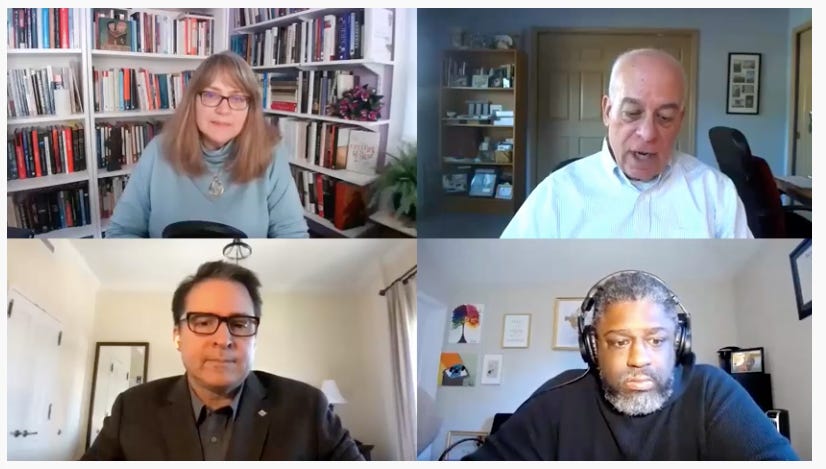
Discover more from The Cottage
On Monday, a friend’s text interrupted my work day. It was from Jeremy Rutledge, the senior minister at Circular Congregational Church in Charleston, South Carolina.
He’d seen a couple of tweets I’d posted on Sunday night in response to a New York Times opinion essay. The article argued that churches should end online services and return to regular, in-person gathering. In some ways, it wasn’t terribly different than arguments for in-person school. But, in the process of making her case, the author managed to demean people who are disabled or suffered from high-risk conditions — and I pointed to that problem on Twitter.
Jeremy’s text read:
“Diana, as an immunocompromised and high risk pastor, I had a visceral response to that NY Times piece. If you’d like to chat, I’m around…”
I called him immediately.
“Hi Jeremy, what’s up? How are you?”
“Well,” he replied, “That essay in the New York Times felt like someone slammed a door in my face.”
He told me how his congregation had responded to the pandemic, especially with the challenge of having a pastor at high risk. “For almost two years,” he said, “I’ve seen people work tirelessly to be and bring church to each other in new ways.”
It was inspiring to watch a congregation that is nearly 3 ½ centuries old change how we do things overnight in order to meet the needs of the moment.
Our recorded services reached farther than we ever imagined. On a regular basis, I still receive letters from far away. People write who have been tuning in because there’s not a progressive church where they live or because what we’re doing resonates with them. I met a woman at church this month who was attending in-person for the first time. She told me that if not for our online services, she wasn’t sure how she would have made it through the last year.
We have learned so much about what it means to really be the church in terms of making a place for the vulnerable, the high risk, the lonely, and the left out. As we have become a church that is both in-person and live-streamed, we have widened the circle of our welcome.
Honestly, it’s all just love. We have done everything we can to care for each other, to stay connected, and to make church available to all in safe and healthy ways. I’ve never seen so many people work so hard for so long trying to make a place for everyone. I think we’ve all been changed by it, and I don’t think any of us want to go back.
For Jeremy and the people at Circular Church, the pandemic opened a door. They’ve been a great church for a long time, a community who accepted LGBTQ people and worked on the front lines of racial justice in South Carolina. But COVID taught them that even inclusive churches didn’t really understand the wideness of welcome — for all their risky work for justice, they’d not seen those whom they’d overlooked.
The vulnerable, the high risk, the lonely, and the left out — including their own pastor.
Sometimes you can’t see until you can see. The people in Charleston got to work. They changed. And they don’t want to go back.
* * * * *
The contrast between Circular’s experience and the article couldn’t have been clearer. Although it made some good points about the importance of bodies and vulnerability, the central claim asserted: “Online church, while it was necessary for a season, diminishes worship and us as people.” It went on to state that “we seek to worship wholly” and insist that “embodiment is an irreducible part of that wholeness.”
Obviously both Pastor Rutledge and the essayist care about good church, the kind of gathering that embodies the presence of God, love of neighbor, and dignifies our full humanity. But where Jeremy’s congregation discovered digital gathering as an entry into wider and more just community, the Times article maintained that online church “diminishes” our humanness.
You might see this as a tempest in a theological teapot. You might argue this as an unnecessary dualism of an either/or choice when a both/and solution is probably the best way forward. But the crux of the matter might be deeper than that. Two questions arise from the tension Jeremy felt when reading the article: What is embodiment? Whose bodies count?
* * * * *
At first, the answers seem simple. A body is a body. And, of course, every body matters.
But it isn’t quite that easy. The Times piece defines “bodies” as material entities and “community” as bodies in the same room with other bodies. Aaron Smith, a podcaster, pinpointed a problem with this: “People have stopped using embodied as ‘taking shape’ and started using it as ‘physical proximity’ which misses the point entirely.”
That’s exactly right. Honoring bodies, embodiment, and vulnerable community are more than putting fleshly beings in a room together. It is about something “taking shape.” And Jeremy’s story hints at the other, harder possibility and work: that of shaping a body.
For as robustly as Christians should and must defend materiality, we also need to recognize that bodies are more than bones and organs. The New Testament uses two words for bodies: sarx and soma. Sarx, often translated as “body,” means “flesh,” literally the tissue and bowels of living bodies. Soma, also translated as “body,” means living bodies but it also has broader meanings that include dead bodies, spirits and non-material bodies, non-conventional bodies, heavenly bodies like stars and planets, and social bodies.
Embodiment doesn’t just mean living flesh in a particular place. But embodiment in a robust understanding extends from skin-and-bones particularity to the larger shape of things as a whole. Embodiment and wholeness are linked. We speak of “the body politic,” the family as a body, an economic unit like a union as a body, the social order in general is often seen as a national or corporate body. Christians speak of the church as a body — and very specifically the body of Christ — and the mystical body of believers. All the faithful are part of a body, “the communion of saints,” that stretches through time and space and knows no fleshly barriers. Bodies are specific and touchable (sarx) and, at the same time, universal and beyond physicality as we know it (soma). In the first sense, embodiment entails physical proximity almost as a necessity. In the second sense, however, embodiment means the shape of things — how we are connected, what we hold to be true, and how we work together for the sake of the whole.
When specific human bodies (sarx) gather together in particular places, they often (and unwittingly) define the communal, more transcendent body (soma) to be composed of only those who are near them. Indeed, throughout western history, people with disabilities, physical limitations, or illnesses were considered to be parasites, plagues, or cancers on the body politic. The social body was poisoned by certain fleshly bodies, leading to eugenics movements and genocides of those with “unfit” bodies. In the church, the mystical body could be polluted by doubters, heretics, infidels, and witches (always identifiable by physical deformities on their bodies) who needed to be exiled, silenced, corrected, or exterminated by any means possible. Understanding embodiment strictly on the terms of flesh and physical proximity has led to some of humanity’s worst episodes of exclusion and violence in both state and church.
Defining embodiment as “the shape of things” or the “shape that things could be” is harder. In this case, we fleshly, limited sarx-humans have to imagine what shape transcendent, communal soma-bodies look like beyond familiar people in familiar places. Creating a body politic or experiencing a mystical body or caring for the body of the Earth — these are hard. But all these bodies call out for consideration, attention, and compassion. They include that which we can touch, hold, and hug, but they also expand our flesh bodies toward the communal body — those we can’t necessarily touch, hold, and hug — as a reality in which we humans find real wholeness, healing, and justice.
And that’s what online church has done. It has challenged us to understand that body is more than sarx. It is also soma. We are individual flesh bodies (that matter greatly) AND are of a piece with the earth’s body, the body of creation, the body of humanity, all sorts of universal, truly “catholic” bodies we struggle to comprehend and yet constantly shape both intentionally and unwittingly. Particular and vast, touchable and transcendent — body, bodies, Body.
* * * * *
Although online church took many forms, I always enjoyed Zoom the most. Occasionally, it seemed weirdly “disembodied,” but Zoom actually gave shape to that more transcendent Body than is typical in a church building. It took us to a place where every single flesh-body was treated equally (we all got the exact same size box), had the same privileges on the screen, and where everyone could fully participate in the work of the people. If you stop and think about it for just a moment, Zoom (in particular) was surprisingly, unexpectedly, annoyingly real. A place where every fleshy body could enter* and every body mattered.
It wasn’t disembodied at all. Those are real people with real bottoms sitting in real chairs on the other side of those screens. We got to see into one another’s worlds, with disruptive children, barking dogs, messy bookshelves and kitchens, and unexpected wheezes, sneezes, and burps. Parishioners in pjs, preachers expounding the Gospel while muted, doughnuts and orange juice standing in for wafers and wine. We saw face-to-face with a kind of astonishing intimacy we didn’t know could happen, with every moment of sadness, shock, joy, silliness, and boredom close-up. Indeed, Zoom glories in our imperfection, invites mistakes and slip-ups, and makes everyone just as awkward and unpolished as everyone else. Online church didn’t diminish but instead magnified us all.
It reminded us that church is far more than what happens in a special building on Sunday morning in the most intrusive and personal ways, drawing our everyday lives into a communal experience that somehow defies the boundaries and walls that often protect our professional and private spaces. It opened up participation to all sorts of sarx-people — and gave us the ability to see our soma-community exists here and now, a truly diverse, inclusive Body that gathers outside of conventional space and time, and that isn’t just a theory, an utopia, or an after-death hope.
Yes, things are changing regarding the pandemic. Many people are eager to return to what used to be. We have better tools to manage the virus and are starting the journey toward whatever comes next. But wherever we go, we shouldn’t just go back. We certainly shouldn’t return to limited ideas of body and embodiment. Old church will happen once again, and perhaps we’ll do it better than we did. But online church wasn’t just a way to adapt to an emergency. It is a gift of opening our theological imagination to the shape of the spiritual community — authentic, meaningful human community — that is being birthed right in our midst. This wasn’t an accident of pandemic or a temporary solution.
Welcome to the Mystical Body of Zoom.
*There is, of course, an important conversation to have about access, broadband availability, and technological equity. Acknowledging problems of economic inequality should not be used to undermine the ways that online community has positively impacted the lives of disabled people, those with unconventional bodies, people isolated for various reasons, victims of trauma, those with long term illnesses, and the elderly — millions of whom have benefited by finally being able to participate in meaningful community because of changes made during the pandemic.
INSPIRATION
O my body! I dare not desert the likes of you in other men and women, nor the likes of the parts of you,
I believe the likes of you are to stand or fall with the likes of the soul, (and that they are the soul,)
I believe the likes of you shall stand or fall with my poems, and that they are my poems,
Man’s, woman’s, child’s, youth’s, wife’s, husband’s, mother’s, father’s, young man’s, young woman’s poems,
Head, neck, hair, ears, drop and tympan of the ears,
Eyes, eye-fringes, iris of the eye, eyebrows, and the waking or sleeping of the lids,
Mouth, tongue, lips, teeth, roof of the mouth, jaws, and the jaw-hinges,
Nose, nostrils of the nose, and the partition,
Cheeks, temples, forehead, chin, throat, back of the neck, neck-slue,
Strong shoulders, manly beard, scapula, hind-shoulders, and the ample side-round of the chest,
Upper-arm, armpit, elbow-socket, lower-arm, arm-sinews, arm-bones,
Wrist and wrist-joints, hand, palm, knuckles, thumb, forefinger, finger-joints, finger-nails,
Broad breast-front, curling hair of the breast, breast-bone, breast-side,
Ribs, belly, backbone, joints of the backbone,
Hips, hip-sockets, hip-strength, inward and outward round, man-balls, man-root,
Strong set of thighs, well carrying the trunk above,
Leg fibres, knee, knee-pan, upper-leg, under-leg,
Ankles, instep, foot-ball, toes, toe-joints, the heel;
All attitudes, all the shapeliness, all the belongings of my or your body or of any one’s body, male or female,
The lung-sponges, the stomach-sac, the bowels sweet and clean,
The brain in its folds inside the skull-frame,
Sympathies, heart-valves, palate-valves, sexuality, maternity,
Womanhood, and all that is a woman, and the man that comes from woman,
The womb, the teats, nipples, breast-milk, tears, laughter, weeping, love-looks, love-perturbations and risings,
The voice, articulation, language, whispering, shouting aloud,
Food, drink, pulse, digestion, sweat, sleep, walking, swimming,
Poise on the hips, leaping, reclining, embracing, arm-curving and tightening,
The continual changes of the flex of the mouth, and around the eyes,
The skin, the sunburnt shade, freckles, hair,
The curious sympathy one feels when feeling with the hand the naked meat of the body,
The circling rivers the breath, and breathing it in and out,
The beauty of the waist, and thence of the hips, and thence downward toward the knees,
The thin red jellies within you or within me, the bones and the marrow in the bones,
The exquisite realization of health;
O I say these are not the parts and poems of the body only, but of the soul,
O I say now these are the soul!
— Walt Whitman, from I Sing the Body Electric
Here’s a link to a recent panel discussion hosted by Brian Allain, with Robert P. Jones, Lamar Hardwick, and me from Compassionate Christianity on progressive faith and politics — it includes very thoughtful discussion of bodies, race, and disability. Check out Robert’s and Lamar’s books and give them a follow on Twitter. Also, Robert has a great newsletter too!








I am 79 and do not drive. The bus service, which I do not take in this time of Omicron, does not start its run until after my church begins. Shared ride services on Sundays are often priced at $32.00 one way. Zoom has meant my attendance every Sunday. What is more, I can now participate in the Bible studies, book clubs, discussion groups, which usually are at 7 PM in the evenings. I have participated in activities at the Diocesan level long denied me. I have met people from across the country, attended evening and morning prayer from England to Grand Rapids, MI. My life in the church has been enriched immeasurably.
My husband of 62 years died in December 2020, and by January I needed to experience a church-based Service of Memory for him. My local church, First Community in Columbus, Ohio, was only able to include the immediate family and staff for the event so we opted to live stream the service, so family and friends could participate. Then the tech guy at the church put the service on a link that we could watch again and refer friends who had missed the live stream to. I can never fully express how much this meant to me or how helpful it was. Three cheers (at least) to the churches that got out of their comfort zone to help during this awful time!
Pidge Diehl